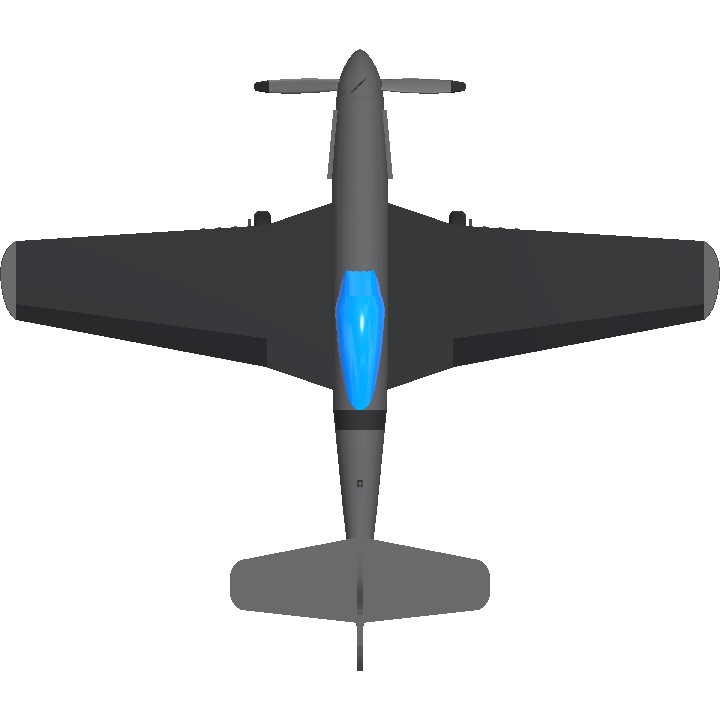Actually there are many users who comment in my post who say that (some of) my planes are cool, but I can't reply the comment one by one, but still thank you for all the upvotes... anyway I also actually now made a PEA aircrafts that had not yet existed in SP web before (or the existed one but with my version of looking and flight performance/traits lol), or any other planes that had not been made by other users yet. That's my all, thanks once again:)
So, let's driftin' to the crow-i mean the cloud~
North American P-51 Mustang
The North American Aviation P-51 Mustang is an American long-range, single-seat fighter and fighter-bomber used during World War II and the Korean War, among other conflicts. The Mustang was designed in 1940 by a team headed by James H. Kindelberger of North American Aviation (NAA) in response to a requirement of the British Purchasing Commission. The commission approached NAA to build Curtiss P-40 fighters under license for the Royal Air Force (RAF). Rather than build an old design from another company, NAA proposed the design and production of a more modern fighter. The prototype NA-73X airframe was completed on 9 September 1940, 102 days after contract signing, achieving its first flight on 26 October.
The Mustang was designed to use the Allison V-1710 engine without an export-sensitive turbosupercharger or a multi-stage supercharger, resulting in limited high-altitude performance. The aircraft was first flown operationally and very successfully by the RAF and as a tactical-reconnaissance aircraft and fighter-bomber (Mustang Mk.I (FB. 1)). In mid 1942, a development project known as the Rolls-Royce Mustang X, replaced the Allison engine with a Rolls-Royce Merlin 65 two-stage inter-cooled supercharged engine. During testing at Rolls-Royce's airfield at Hucknall in England, it was clear the engine dramatically improved the aircraft's performance at altitudes above 15,000 ft (4,600 m) without sacrificing range. Following receipt of the test results and after further flights by a number of USAAF pilots, the results were so positive that North American began work on converting several aircraft developing into the P-51B/C (Mustang Mk.III (F. 3)) model, which became the first long range fighter to be able to compete with the Luftwaffe's fighters. The definitive version, the P-51D, was powered by the Packard V-1650-7, a license-built version of the two-speed, two-stage-supercharged Merlin 66, and was armed with six .50 caliber (12.7 mm) AN/M2 Browning machine guns.
From late 1943 into 1945, P-51Bs and P-51Cs (supplemented by P-51Ds from mid-1944) were used by the USAAF's Eighth Air Force to escort bombers in raids over Germany, while the RAF's Second Tactical Air Force and the USAAF's Ninth Air Force used the Merlin-powered Mustangs as fighter-bombers, roles in which the Mustang helped ensure Allied air superiority in 1944. The P-51 was also used by Allied air forces in the North African, Mediterranean, Italian, and Pacific theaters. During World War II, Mustang pilots claimed to have destroyed 4,950 enemy aircraft.
At the start of the Korean War, the Mustang, by then redesignated F-51, was the main fighter of the United States until jet fighters, including North American's F-86 Sabre, took over this role; the Mustang then became a specialized fighter-bomber. Despite the advent of jet fighters, the Mustang remained in service with some air forces until the early 1980s. After the Korean War, Mustangs became popular civilian warbirds and air racing aircraft (some airframes remains airworthy even today!).
Possible nicknames, reflecting its characteristics and the experiences of pilots who flew it:
"Cadillac of the Skies": Perhaps the most common nickname, reflecting the aircraft's perceived smoothness, power, and overall high quality.
"Sweetheart": A term of endearment often used by pilots to describe their aircraft.
"Jug Killer": A more colorful name jokingly referring the P-51's superior performance against the P-47 Thunderbolt (the "Jug"), though the P-47 was a valuable fighter-bomber in its own right.
"The Aluminum Overcast": Often used to describe Mustangs that were unpainted or had their paint stripped to save weight.
"The Exterminator": Due to it's success againist the threat of enemy fighters.
"The Aluminum Overcast": A reference to its unpainted, natural metal finish.
- About the variant
P-51D (NA-109/110/111/122/124) series (includes Mustang Mk.IV (F. 4))
As well as the modified fuselage and new canopy the production P-51Ds had modified wings compared with the P-51B/C series and became the most widely produced variant of the Mustang, with 6,502 being built at Inglewood and 1,600 at Dallas – a combined total of 8,102. 280 were used by the RAF and designated Mustang Mk.IV
C O N T R O L S
Trim : Flaps, cruising 'rotate' adjuster
VTOL : Further flaps
Specifications
Spotlights
- ThomasRoderick 4 days ago
General Characteristics
- Created On Android
- Wingspan 37.6ft (11.4m)
- Length 32.5ft (9.9m)
- Height 12.0ft (3.7m)
- Empty Weight 4,565lbs (2,070kg)
- Loaded Weight 7,293lbs (3,308kg)
Performance
- Horse Power/Weight Ratio 0.239
- Wing Loading 14.0lbs/ft2 (68.2kg/m2)
- Wing Area 522.0ft2 (48.5m2)
- Drag Points 1593
Parts
- Number of Parts 76
- Control Surfaces 7
- Performance Cost 498







Please make a P-40 next